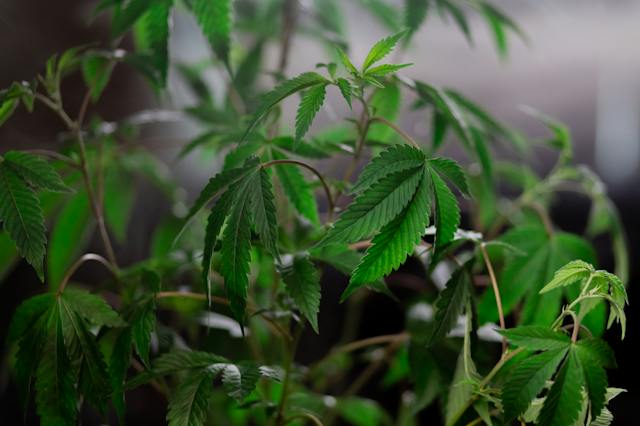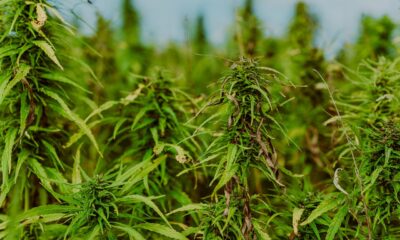Cannabis
The Illegal Cannabis Market in Europe Reaches €11.4 Billion
Although the EMCDDA has indicated that its data on cannabis production sites in the EU is “incomplete,” it suggests that some 7,000 illegal cultivation crops were eradicated in 2019 in 14 member states. The scale of the illegal cannabis market is estimated to have a significant environmental impact, given the high water and energy demands associated with growing large quantities of cannabis.

Last week, the European Monitoring Center for Drugs and Drug Addiction (EMCDDA) published a detailed report on the illegal cannabis market in the European Union.
The report, based on the latest EMCDDA data and co-authored by Europol, reveals the size of the illegal cannabis market, valued at €11.4 billion and serving 22.6 million Europeans over the past year.
While the size of the market “remains stable,” the report points out market trends, including a significant increase in THC potency, the rapid emergence of semi-synthetic cannabinoids such as HHC, and the environmental impact of illegal cannabis cultivation in Europe.
“All of these developments come at a time when there is a political debate in Europe and around the world that is affecting both legal and illegal markets, creating challenges for law enforcement and justice systems,” said Andrew Cunningham, head of markets, crime, and supply at EMCDDA, during a webinar launching the report.
Read more about the illegal cannabis market in Europe and find the latest cannabis news from around the world, with the Hemp.im mobile app.
Spain, Morocco, and the Western Balkans
With an estimated 22.6 million consumers last year, cannabis is the most widely used illicit substance in Europe, and by far, as it is six times more popular than cocaine, the second most used illicit substance.
Cannabis, or dried cannabis flowers, accounts for more than three-quarters (77%) of the total market value (at least €8.8 billion), while cannabis resin accounts for the remaining 23%, estimated at about 362 tons.
The amount of cannabis seized in the EU, Norway, and Turkey reached record levels in 2021, with more than 288 tons. According to available data, most of the cannabis seized in the EU comes from several countries.
One of them is Spain, which accounted for about 51% of the total amount of cannabis seized in the EU in 2021, or about 130 tons, while Italy (47 tons) and France (nearly 40 tons) together accounted for another third.
These numbers were overshadowed by a record 850 tons of cannabis resin seized in 2021 in the EU, Norway, and Turkey, with Spain again accounting for the majority of seizures, some 82%.
“Most of the cannabis resin available on the European market comes from Morocco, and due to its geographic location, Spain is the main entry point into the EU,” said Robert Patrancus, scientific analyst at EMCDDA.
In the case of cannabis, the report suggests that the majority is grown in the EU, but the Western Balkan region remains an important EU supply point for cannabis. That situation is beginning to change, however, and Albania’s efforts to address the problem appear to have led to a reduction in arrests since 2018.
“As part of these changes, in order to get closer to the main consumption market, some criminal networks from the Western Balkans have adopted a new business model by engaging in cannabis cultivation and trafficking inside the EU.”
Importantly, since North Macedonia legalized the production of cannabis for medical purposes in 2016, “large quantities” of legally grown products are being diverted to the illegal market, a trend also seen in Albania.
Although the Americas, West Africa, and Southeast Asia are no longer considered major sources of illegal cannabis imports, there has been a recent “increase in the frequency of trafficking of cannabis originating in Canada and the United States.”

Semi-synthetic cannabinoids
Another important issue raised in the report is the growing range of different cannabis-based products that go beyond the “old hashish + herb model,” with vape pens, edibles with THC, oils, and extracts now readily available to consumers across Europe.
Data suggest that cannabis’ THC content has increased by 57% in the herb over the past decade, and by nearly 200% in the resin, likely due to improvements in genetics and extraction techniques.
Cannabis has also become more affordable, with data taking into account costs “adjusted for purity or potency in the context of a country’s standard of living” suggesting that “for the same amount of money, you can get 25% more THC than before.”
The development of semi-synthetic cannabinoids, which, according to the EMCDDA, are “mainly made from CBD,” is a worrying aspect of this diversification of a market that is growing rapidly.
Substances such as HHC, Delta-8, and Delta-10-THC occur naturally in the cannabis plant in small amounts, EMCDDA explains, but producers are now commonly converting non-psychoactive CBD into these psychoactive substances in laboratories.
“CBD has become a precursor,” said Laurent Laniel, EMCDDA’s chief scientific analyst, during the webinar.
“Why did people suddenly decide to produce these new semi-synthetic CBD extracts? Because there was an overproduction of CBD in the United States and Canada. People invested money in producing CBD and couldn’t sell it on the market, so they turned it into these new products so they wouldn’t lose their entire investment and even make a profit.”
The danger, he added, is that these substances are new and we don’t yet have enough data to determine whether they can be safely consumed.
Environmental impact of illegal cannabis production
Although the EMCDDA has indicated that its data on cannabis production sites in the EU is “incomplete,” it suggests that some 7,000 illegal cultivation crops were eradicated in 2019 in 14 member states. In 2020 and 2021, those numbers rose to 10,000 and 9,000, respectively.
The number of cannabis plants seized, a “key indicator” used to determine the scale of the illicit market, reached 4.3 million in 2021, with about 3.2 million of them in Spain, nearly doubling from 2020.
In Turkey, the number of seized cannabis plants in 2021 was 18 times higher than in the EU as a whole, reaching 76 million.
The scale of the illegal cannabis market is estimated to have a significant environmental impact, given the high water and energy demands associated with growing large quantities of cannabis, while available data is also improving due to the growing number of regulated markets in the EU.
Growing one kilogram of cannabis internally requires about 6,000 kilowatt-hours of electricity, equivalent to about 1,400 kilograms of carbon footprint.
By comparison, the Dutch electricity supplier suggested that the stolen electricity for cannabis production in 2021 was about 1 billion kilowatt hours. That’s equivalent to the annual electricity consumption of households in a city the size of Rotterdam.
The EMCDDA gave specific examples of a crop eradicated in Spain that contained 400,000 plants. Taking these figures into account, one crop cycle would require about 1.8 billion liters of water, equivalent to the daily consumption of a country the size of Latvia.
Even so, the carbon footprint of growing cannabis indoors is estimated to be 60 to 100 times that of growing outdoors. As an example, to achieve the carbon footprint of one twist of cannabis (0.3 g) grown outdoors, one would have to drive 70 meters in a hybrid electric vehicle. For cannabis grown indoors, that number rises to 4.6 kilometers.
__
(Featured image by Pavel Danilyuk via Pexels)
DISCLAIMER: This article was written by a third party contributor and does not reflect the opinion of Born2Invest, its management, staff or its associates. Please review our disclaimer for more information.
This article may include forward-looking statements. These forward-looking statements generally are identified by the words “believe,” “project,” “estimate,” “become,” “plan,” “will,” and similar expressions. These forward-looking statements involve known and unknown risks as well as uncertainties, including those discussed in the following cautionary statements and elsewhere in this article and on this site. Although the Company may believe that its expectations are based on reasonable assumptions, the actual results that the Company may achieve may differ materially from any forward-looking statements, which reflect the opinions of the management of the Company only as of the date hereof. Additionally, please make sure to read these important disclosures.
First published in FaktyKonopne. A third-party contributor translated and adapted the article from the original. In case of discrepancy, the original will prevail.
Although we made reasonable efforts to provide accurate translations, some parts may be incorrect. Born2Invest assumes no responsibility for errors, omissions or ambiguities in the translations provided on this website. Any person or entity relying on translated content does so at their own risk. Born2Invest is not responsible for losses caused by such reliance on the accuracy or reliability of translated information. If you wish to report an error or inaccuracy in the translation, we encourage you to contact us.

-

 Cannabis2 weeks ago
Cannabis2 weeks agoRemexian Wins Legal Battles Amid German Cannabis Licensing Dispute
-

 Impact Investing4 days ago
Impact Investing4 days agoHigh Awareness, Low Adoption: The VSME Challenge for European SMEs
-

 Fintech2 weeks ago
Fintech2 weeks agoItaly Issues First Natively Tokenized Minibond on Public Blockchain
-

 Fintech1 week ago
Fintech1 week agoN26 Hires UBS Executive to Lead Turnaround Amid Regulatory Pressure























